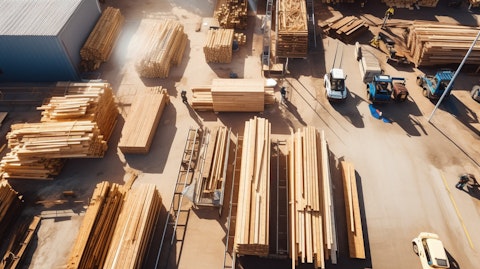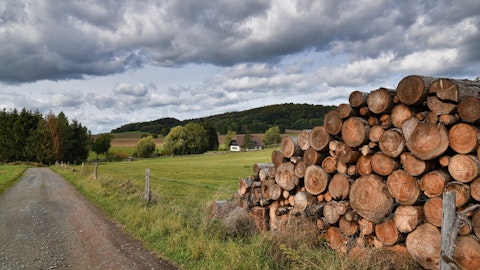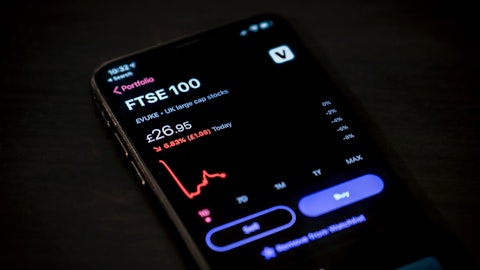Boise Cascade Company (NYSE:BCC) Q3 2023 Earnings Call Transcript October 31, 2023
Operator: Good morning. My name is Chris, and I will be your conference facilitator today. At this time, I would like to welcome everyone to Boise Cascade’s Third Quarter 2023 Earnings Conference Call. All lines have been placed on mute to prevent any background noise. After the speaker’s remarks, there will be a question-and-answer period. It is now my pleasure to introduce you to Kelly Hibbs, Senior Vice President, CFO and Treasurer of Boise Cascade. Mr. Hibbs, you may begin your conference.
Kelly Hibbs: Thank you, Chris, and good morning everyone. I would like to welcome you to Boise Cascade’s third quarter 2023 earnings call and business update. Joining me on today’s call are Nate Jorgensen, our CEO; Mike Brown, Head of our Wood Products Operations; and Jeff Strom, Head of our Building Materials Distribution Operations. Turning to Slide 2. This call will contain forward-looking statements. Please review the warning statements in our press release, on the presentation slides and in our filings with the SEC regarding the risks associated with these forward-looking statements. Also, please note that the appendix includes reconciliations from our GAAP net income to EBITDA and adjusted EBITDA and segment income to segment EBITDA. I will now turn the call over to Nate.
Nate Jorgensen: Thanks, Kelly. Good morning, everyone. Thank you for joining us on our earnings call today. I’m on Slide number 3. Our consolidated third quarter sales of $1.8 billion were down 15% from third quarter 2022. Our net income was $143.1 million, or $3.58 per share, compared to net income of $219.6 million, or $5.52 per share, in the year ago quarter. Total U.S. housing starts declined 6%, driven by a decrease in multifamily housing compared to prior year quarter. However, single-family housing starts to increase 7% compared to the same period in 2022. Both of our businesses again delivered solid operating and financial results. I want to thank our associates for their continued focus, hard work and loyalty as we continue to navigate ongoing economic uncertainties.
As recently announced, we completed the acquisition of BROSCO and I’m pleased to welcome their outstanding team to Boise Cascade. We will provide additional details on this transaction following the discussion of our financial results. Kelly will now walk through our segment financial results, provide an update on our capital allocation, and discuss the BROSCO Bronco acquisition in more detail, after which I’ll provide our outlook before we take your questions. Kelly?
Kelly Hibbs: Thank you, Nate. Wood Products sales in the third quarter, including sales to our distribution segment were $515.2 million compared to $595.3 million in third quarter 2022. Wood Products reported segment EBITDA of $122.9 million, down from EBITDA of $177.3 million reported in the year ago quarter. The decrease in segment EBITDA was due primarily to lower EWP and plywood sales prices as well as lower LVL sales volumes. These decreases were offset partially by lower wood fiber costs and higher plywood sales volumes. BMD sales in the quarter were $1.7 billion, down 15% from third quarter 2022. Lower pricing across product lines negatively impacted BMD’s year-over-year revenue comparison. However, BMD’s gross profit and EBITDA margins were again strong during the third quarter.
BMD reported segment EBITDA of $104.9 million in the third quarter compared to segment EBITDA of $161.2 million in the prior year quarter. The decline in segment EBITDA was driven by a gross margin decrease of $48.4 million. In addition, selling and distribution expenses increased $6 million. Moving to Slide 5. On a year-over-year basis, third quarter volumes for I-joists were flat, while volumes for LVL were down 5%. On a sequential basis, volumes for LVL and I-joists increased by 6% and 2%, respectively. Sequential pricing for LVL and I-joists was down 4% and 3%, respectively. Our strong volumes in the third quarter and consistent lead times to our customer base are a great testament to our Wood Products team and their ability to respond to stronger-than-expected demand in 2023.
Looking forward to the fourth quarter, October volumes are modestly below third quarter monthly average levels with recent declines in our order files indicative of the expected seasonal slowdown in construction activity. As such, in fourth quarter, we would expect sequential volume declines but meaningful year-over-year increases. On EWP pricing, we currently expect modest single-digit sequential price declines in the fourth quarter. Turning to Slide 6. Our third quarter plywood sales volumes in Wood Products was 390 million feet compared to 329 million feet in third quarter 2022. Our plywood sales team was effective in finding market opportunities, including the sale of incremental volumes related to the acquisition of the Chapman and Havana mills.
Prior year volumes were also negatively impacted by downtime taken to replace an existing dryer at our Chester, South Carolina plywood facility. $392 per 1,000 average plywood net sales price in third quarter was down 20% from third quarter 2022 and up 5% sequentially. Thus far in the fourth quarter, plywood price realizations are modestly above our third quarter average. Moving to Slide 7 and 8. BMD’s third quarter sales were $1.7 billion, down 15% from third quarter 2022, driven by sales price and sales volume decreases of 14% and 1%, respectively. By product line, commodity sales decreased 20%. General line product sales decreased 5%, and sales of EWP decreased 21%. Gross margin dollars decreased by $48.4 million in third quarter compared with the same quarter last year.

As expected, lower margins on EWP were the principal driver of the decline in margin dollars with the impact of a declining instead of a rising price environment negatively impacting results. However, BMD’s overall gross margin percentage held strong at 15.2%, down only 20 basis points from the 15.4% reported in third quarter 2022 as we avoided the negative impacts from a declining commodity pricing environment that we experienced during 2022. BMD’s EBITDA margin was 6.3% for the quarter, down from the 8.2% reported in the year ago quarter and down 20 basis points sequentially. BMD sales pace thus far in fourth quarter 2023 is seasonally weaker or approximately 6% below daily sales averages in third quarter. However, with inventory management, a clear focus for the industry in 2023 and a restored supply chain, we view inventory in the channel as appropriately positioned across most product lines.
As such, we’d expect fourth quarter takeaways to generally align with market activity as opposed to the destocking events of last year. And as we have indicated before, reliance on two-step distribution is expected to remain strong when customers look to manage inventory volume and price risk. We anticipate lower EBITDA margins in the fourth quarter, resulting from deleveraging of fixed costs as sales decline, BROSCO acquisition-related costs and the potential of gross margin degradation from product price erosion. Moving to Slides 9 and 10. These slides show the generally stable pricing environment for lumber and panel pricing during third quarter 2023 compared with the downward trajectory during the prior year quarter. While future price volatility is likely, we will maintain our approach to having inventory on hand to support our customer base.
I’m now on Slide 11. We had capital expenditures of $99 million during the nine months ended September 30, 2023, with $31 million of spending in Wood Products and $68 million of spending in BMD. In Wood Products, we continue to progress with our multiyear capacity expansion projects in the Southeast U.S. In BMD, our execution of organic growth continues, including our Kansas City and Denver door shops and the purchase of a distribution center in West Palm Beach, Florida. Our full year 2023 expected range for capital spending is now $190 million to $210 million. We have yet to finalize our capital spending plans for 2024, but would expect it to be – would expect it to exceed $200 million as we work towards completion of previously announced growth projects and also have a good mix of maintenance, resilience and additional growth projects ahead of us.
Speaking to shareholder returns, we paid $141 million in regular and special dividends to shareholders during the nine months ended September 30, 2023. And last week, our Board of Directors approved a $0.20 per share quarterly dividend and a $5 per share special dividend. Including the expected fourth quarter amounts, full year 2023 dividends will be approximately $347 million. In addition, share repurchases are another manner in which we can return cash to our shareholders, and we have approximately 2 million shares available for repurchase under our share repurchase program. In summary, our balance sheet remains very strong, and our approach to capital allocation is unchanged. We will continue to invest in our existing asset base and organic growth projects pursue M&A that aligns with our strategy, remain committed to our fixed dividend through the business cycle and opportunistically return additional capital to shareholders as appropriate via special dividends or share repurchases.
Turning to Slide 12. We are pleased to have completed the acquisition of BROSCO on October 2 for a purchase price of $168 million, including estimated working capital at closing of $51 million. We funded the transaction with cash on hand. The acquisition price included the purchase of BROSCO’s two full-scale distribution centers in Hatfield, Massachusetts and Portland, Maine and provides us immediate scale in the Northeast with LTM September revenue and EBITDA of approximately $191 million and $19 million, respectively. Along with interior and exterior doors, these facilities also offer moldings, railings, windows, stair parts and other general line products. The addition of these products are a nice enhancement to BMD’s legacy general line product mix, and we are excited to be able to offer an expanded product offering to our customer base in the Northeast.
I will turn it back over to Nate to discuss our business outlook.
Nate Jorgensen: Thanks, Kelly. I’m on Slide number 13. Our current estimates for 2023 U.S. housing starts are 1.4 million units compared with actual housing starts of 1.55 million in 2022 as reported by the U.S. Census Bureau. Throughout 2023, home affordability has been a challenge for consumers given higher mortgage rates and limited home price decreases. However, given a resilient economy and low levels of existing home inventory for sale, demand for new residential construction has been stronger than anticipated. Homebuilders have also addressed affordability challenges facing homebuyers in various ways, including smaller home sizes, fewer amenities, price incentives, and mortgage rate buydowns. Economic uncertainties, escalating mortgage rates, and home affordability are expected to continue to influence the near-term demand environment.
Consensus forecasts for 2024 single- and multi-family housing starts in the U.S. generally range from 1.3 million to 1.4 million units, which is comparable with 2023. Regarding home improvement spending, industry forecasts project continued moderation of year-over-year growth in renovation spending, and economic uncertainty may also negatively impact homeowners’ further investment in their residences. Despite these near-term uncertainties, we believe the longer-term demand drivers for new residential construction and repair and remodeling activity continues to be favorable, supported by strong demographic trends, low home inventory and the age of U.S. housing stock. As such, we will remain clearly focused on the execution of our strategies and have great conviction around our investments to grow the company.
Lastly, I’m very pleased with the early integration efforts related to the newly acquired BROSCO facilities. I want to express my gratitude to all of our associates throughout the organization, including our newest associates at BROSCO. We’re keeping a sharp focus on our customers and working safely and effectively. Thank you for joining us for today for and your continued support and interest in Boise Cascade. We would welcome any questions at this time. Chris, would you please open the phone lines.
See also 12 Best Long-Term Stocks To Buy According To Warren Buffett and 11 Best Immunotherapy Stocks To Buy Now.
Q&A Session
Follow Boise Cascade Co (NYSE:BCC)
Follow Boise Cascade Co (NYSE:BCC)
Operator: Thank you. [Operator Instructions] One moment please for our first question. Our first question will come from Susan Maklari of GS. Your line is open.
Susan Maklari: Thank you. Good morning everyone.
Nate Jorgensen: Good morning, Sue.
Kelly Hibbs: Good morning, Sue.
Susan Maklari: I guess my first question is talking a bit about the demand environment. I appreciate the color that you gave in your prepared remarks. But can you talk a little bit about the divergence that I think we’re seeing in terms of the R&R end markets, while the new home construction stays fairly resilient. And I guess how are you thinking about the current pace of starts that’s flowing through your business and the ability to capture that reacceleration that we saw in starts as we move through this year?
Nate Jorgensen: Yes. Sue, its Nate. Maybe just in terms of the repair and remodel activity, I think the – and then also new home sales, today we still see good pace on our repair and remodel business. And so that – I think that activity remains steady. And I think to me, it speaks to a couple of things, including really the importance of two-step distribution in terms of supporting that marketplace. So we feel good about kind of the pace of that business. Obviously, the relationships that we have on the supply side in support of that business, and again the alignment we have with that marketplace. So to me, that would be probably the key item is, again, the pace and consistency on repair and remodel remains pretty good. I would say, in terms of the kind of prepared for new home construction and kind of maybe the resiliency that the team demonstrated the wood products team and distribution team demonstrated in 2023.
I think we had really thoughtful plans that both teams put together. We were working closely with our customer base and making sure we have great clarity in terms of what their inventory positions are, what the pace of business was and we were – we made some early, and I think, important and effective decisions on putting our production capacity at levels to support a marketplace that frankly surprised the upside. And I think as we think about 2024, Sue, we’ll have that same kind of planning, and work and diligence to make sure that we’re staying close to the marketplace and prepare to serve the marketplace should there be an upside surprise or a downside risk associated with that. Kelly, anything you would add just in terms of the backdrop on housing and the recurring remodel?
Kelly Hibbs: Yes, happy to, Nate. So I guess maybe starting with single first. And I know, Sue, you’re very close to the builders and it seems like the national homebuilders are still relatively bullish, and they continue to want to increase their land position and build out new single-family, so that seems to be that, that could be flat to actually somewhat up year-over-year, 2023 to 2024. We’ll see how that plays out. On multifamily, there does seem to be a bit of a pause, more concerns there around financing and potentially oversupply. And as you know, new single-family is a bigger driver for us. In terms of R&R, we all typically think of R&R spending as it relates to sales of existing homes. And as we know, those are down a fair bit this year.
But yet R&R has held up a fair bit, which I think speaks to the fact that people, I think, they have a good amount of equity in their homes and maybe they purchased a home a year or two ago that maybe they didn’t quite have the amenities they wanted. And so we’re seeing maybe a little bit more R&R spending because of that dynamic.
Susan Maklari: That’s encouraging. Good to hear that. And maybe turning the conversation a bit, any thoughts on how we should think about the margins in BMD as we kind of consider a world where wood product prices could be moving lower. And I guess with that too, any implications to those BMD margins from the BROSCO acquisition?


